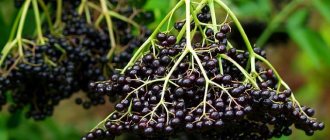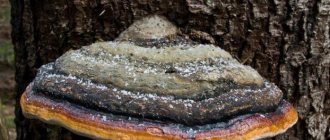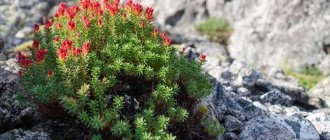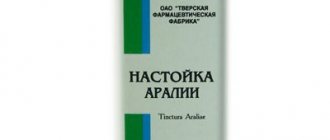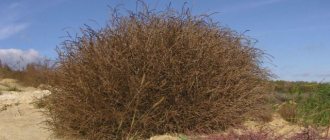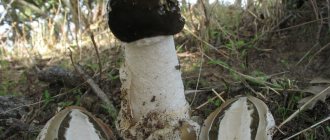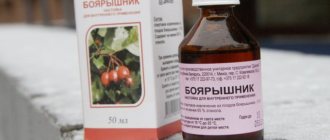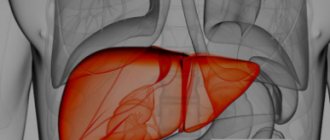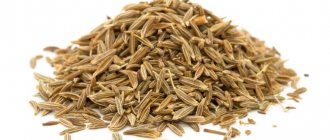People have come up with many names for knotweed: bird knotweed, murava, bird buckwheat, goose grass, ostudnik, hernia grass, trampling grass, goose grass.
It received its most common name for its ability to quickly, “quickly” grow back after damage and mowing.
Appearance
Every villager knows from childhood what knotweed grass looks like. This is an annual plant up to 60 cm tall, but usually spreads along the ground, so it is perceived as shorter.
The stem is highly branched, with pronounced nodes, and becomes hard after flowering. The leaves are small, elliptical or oblong.
In spring, the leaves have a soft emerald hue, in summer they become dark green with a grayish tint, and by autumn they become ocher. Very small white or pink flowers sit in the axils of the leaves.
It blooms all summer and half of autumn, the peak of flowering depends on the area, on average it occurs in July.
The fruit is a small nut with three sides from brown to black. You will probably remember knotweed grass if you look at the photo.
Places of growth
In the territory of the former USSR, the knotweed grows everywhere except the Arctic.
Most often it can be found in meadows, wastelands, banks of reservoirs, near roads and residential buildings. It is undemanding to soil composition and moisture conditions, and can even grow on clay and gravel.
Uses of knotweed
A little about the use of knotweed herb. Previously, dyes were made from this plant: various warm colors were produced from the above-ground part, and blue paint was produced from the underground part.
Ant is excellent for livestock feed; birds especially love it, which is reflected in some variations of the name.
In the cuisines of many nations, young shoots are added to various hot dishes, salads and baked goods.Greens are added to soups at the end of cooking so that the knotweed herb retains its beneficial properties.
Contraindications and precautions
Despite recommendations for using knotweed herb to increase the likelihood of conception, you should not drink it during pregnancy, as it increases the tone of the uterus, which creates a risk of miscarriage.
- Lyubka bifolia - medicinal properties and the best recipes from traditional medicine (110 photos)
- Jaundice - description of the plant, medicinal properties and features of use in folk medicine (80 photos)
Field thistle - medicinal properties, recipes, uses and contraindications of thistle (video + photo)
This medicine is not suitable for hypotensive patients either, because it lowers blood pressure. It can also be harmful in acute kidney diseases.
Herbal medicine, like any treatment, requires prior consultation with a doctor. A specialist will help you figure out whether you have contraindications to the use of knotweed herb.
Medicinal properties
Knotweed herb is part of urological preparations and is used in medical practice for the complex treatment of diseases of the genitourinary system, in case of chronic pathology.
Knotweed is combined with various medicinal plants and, as part of a phyto-mixture, actively influences the dynamics of disease treatment. The main phytotherapeutic properties of knotweed:
- diuretics;
- antibacterial;
- regulating urodynamics;
- regulating local metabolism in the male reproductive system;
- antispasmodic.
Experienced herbalists (herbalists) prescribe medicinal diuretic mixtures for regular therapeutic and preventive use.
Self-harvesting knotweed
Bird knotweed is stored during flowering. The top 30 cm of shoots need to be mowed or cut off, leaving the lower hard part.
Contaminated areas and pastures are not suitable for harvesting medicinal raw materials. The farther the collection site is from roads and industrial enterprises, the better.
The cut parts of the plants are laid out in a thin layer in a warm, shaded place and dried until brittle, turning over periodically.
Store dried knotweed in fabric bags or jars with a ventilated lid for up to 3 years. Stocks of nondescript ants will come to the rescue in case of illness.
Knotweed herb - use in folk medicine
In many areas of medicine, preparations made from the knotweed herb are used. There are various options for using decoctions and infusions in recipes. Apply this way:
- Externally, knotweed is in the form of a decoction. They are used as lotions for treating wounds - they contain tannins and antiseptic substances. Used as a rinse for hair loss and to treat skin diseases.
- For douching for gynecological inflammations.
- Drink infusions internally for acute diseases of the stomach and kidneys.
Decoctions of knotweed
One of the forms of using a medicinal plant is decoctions. They are used for gargling, preparing compresses and lotions, foot baths, and for internal use. To make a decoction you need:
- Pour 10 grams of dry raw material with water - 400 ml;
- boil for 20 minutes;
- cool;
- strain.
- Varieties of cucumbers for a polycarbonate greenhouse
- Nevus - what is it with the photo. Causes and surgical removal of nevus from the body or face
- Height and weight ratio, tables and calculation formulas
Infusion of bird knotweed
Using knotweed in the form of an infusion is more powerful due to the technology of preparation in a water bath. It helps to extract beneficial substances from the plant. The finished infusion is stored in the refrigerator. For preparation you need:
- take a spoonful of dry raw materials;
- add 30 ml of water;
- keep covered in a bathhouse for 20 minutes;
- remove from heat, leave for an hour;
- strain;
- add boiled water to 200 ml.
Bird buckwheat tea
In folk medicine, the medicinal plant is used to treat respiratory diseases, bronchitis complicated by a severe cough. Teas are prepared for this purpose. They help relieve inflammation and have an antibacterial effect. They drink 3 cups of tea per day. To prepare you need:
- take 8 spoons with the top of dry knotweed leaves;
- pour a liter of cold water;
- boil;
- take off;
- strain.
Knotweed juice
To increase immunity, treat abscesses, stomach ulcers, use fresh plant juice. The healing composition helps to dissolve the stones into fine sand and painlessly remove it from the bladder. To prepare juice, you need to collect raw materials during flowering. On prescription:
- the grass is cleared of dry leaves;
- remove roots;
- grind using a meat grinder or blender;
- squeeze through several layers of gauze.
Photo of knotweed grass
Read here! Snake knotweed - description, recipes, use, properties and contraindications for use (105 photos)
Please repost
0
2
Collection and procurement of raw materials
The upper part of the branches (40 cm), leaves and especially flowers are considered useful.
Harvesting is carried out throughout the summer. It is recommended to carry it out in dry weather in unpolluted places far from livestock grazing and dwellings.
For drying, use darkened but well-ventilated places. Under direct sunlight, many important medicinal qualities of the plant are lost. Suitable places for drying: well-ventilated attics, drying rooms, sheds.
We recommend reading: Buckthorn bark - medicinal properties and uses
When collecting grass in the same place, you need to leave up to 25% of the plants to preserve them in this area. The raw materials are suitable for use for 3 years. It has a tart taste.
